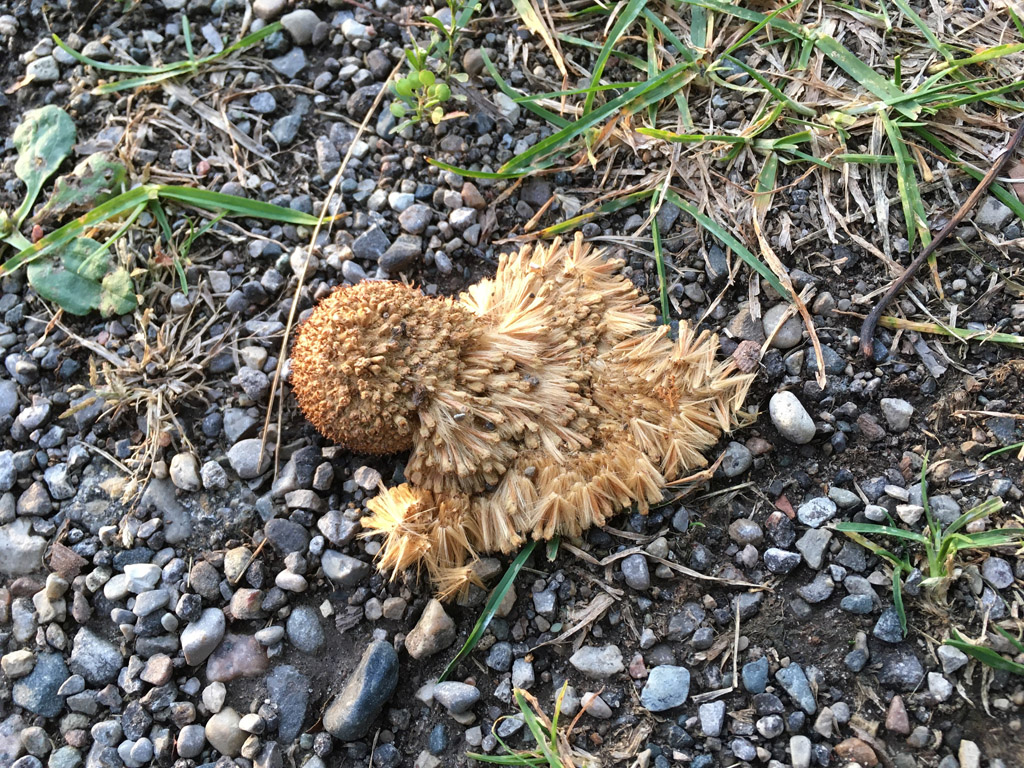One mid-October morning, an energetic breeze blew up, whistling past the burdened gutters, which had long since come to regret their welcome of last year’s leaves. Soon the rush of wind was joined by the flutter and scratch of a catbird flock, industriously mining the gutter muck for grubs and centipedes. An untrimmed branch then added a rhythmic scrape to the chorus, suggesting a second way I might spend this idle day, undoing the work of my neglect. But just as dozens of times before, I turned the thought away. My work inside was much more near and much more satisfying, than to dress and drape for outdoor work on a cold and windy day.
But then, as if to test this settled stance, I heard a sudden thump upon the eaves. A squirrel on the roof, I thought, attempting a breezy leap from bough to beam? A maple reaches toward but doesn’t touch the peak of the gable end, leaving an airy gap just wide enough to test their sense of flight. A squirrel’s leap is quite a twitchy thing; this interruption I’ll forgive, for the image that it brings.
But then I heard another hollow thump, and several more. Some rattled down the roof and leapt the eave. This couldn’t be a squirrel, then. A neighbor earned my first suspicious thought — he’s introduced himself before, by raining golfballs down upon my sprawling, fallowed lawn. Perhaps his stroke’s improved. (Can any neighbor live too far from me?)
But when I stepped outside, I saw a ball of a different sort — hundreds of sycamore seed balls, all fallen, one by one.
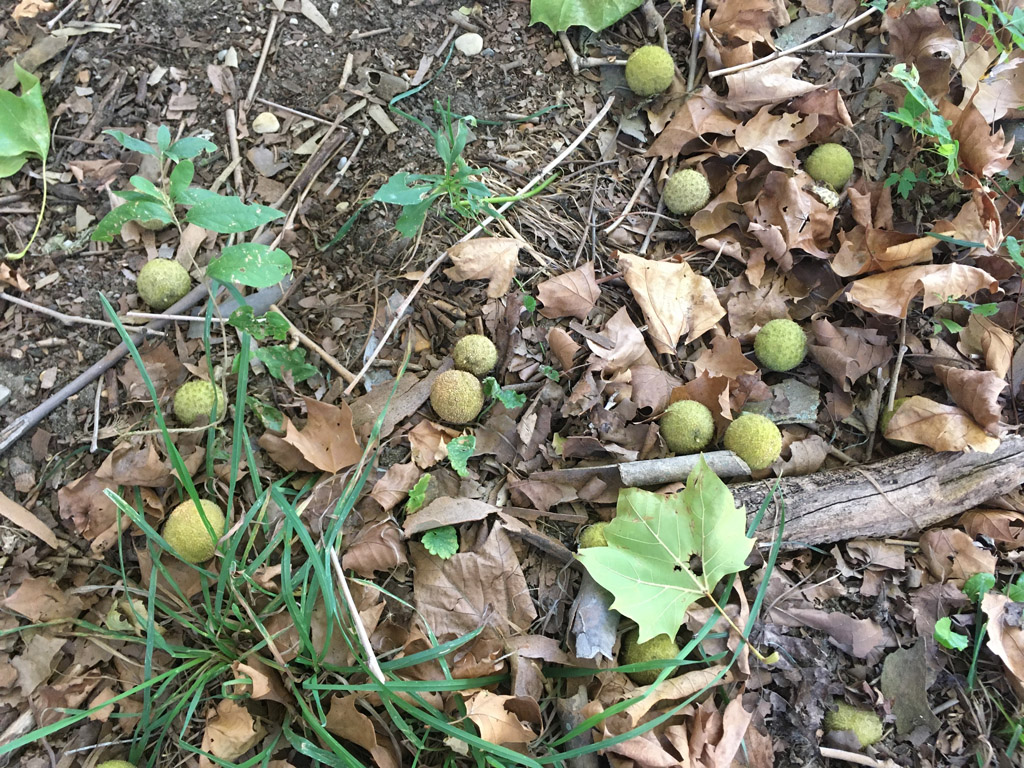
A bumper crop
This house has always been shaded by a massive sycamore, probably since the farm was just a field. Days before, I had already noticed that the ground was unusually littered with its hard, green seedballs, making a stroll across the yard rather like walking on marbles. Those that landed on the driveway would make an entertaining thwoompk as I drove over them, their sudden collapse reverberating through the pressurized air of the tires. I’d also noticed other things that weren’t quite right — as if this sycamore’s littering ways had been altered by a tiny force of will. Instead of just sitting on the ground, a statistically unlikely percentage had somehow found some degree of shelter, having improbably rolled into a corner, or sunk halfway into a patch of dirt, or crawled beneath a piece of bark or a layer of leaves and twigs. A potted plant had begun to overflow with far more than it possibly could have caught in random fall. And today they were raining down again, at a very regular pace – about once every fifteen seconds. One almost hit me on the head.
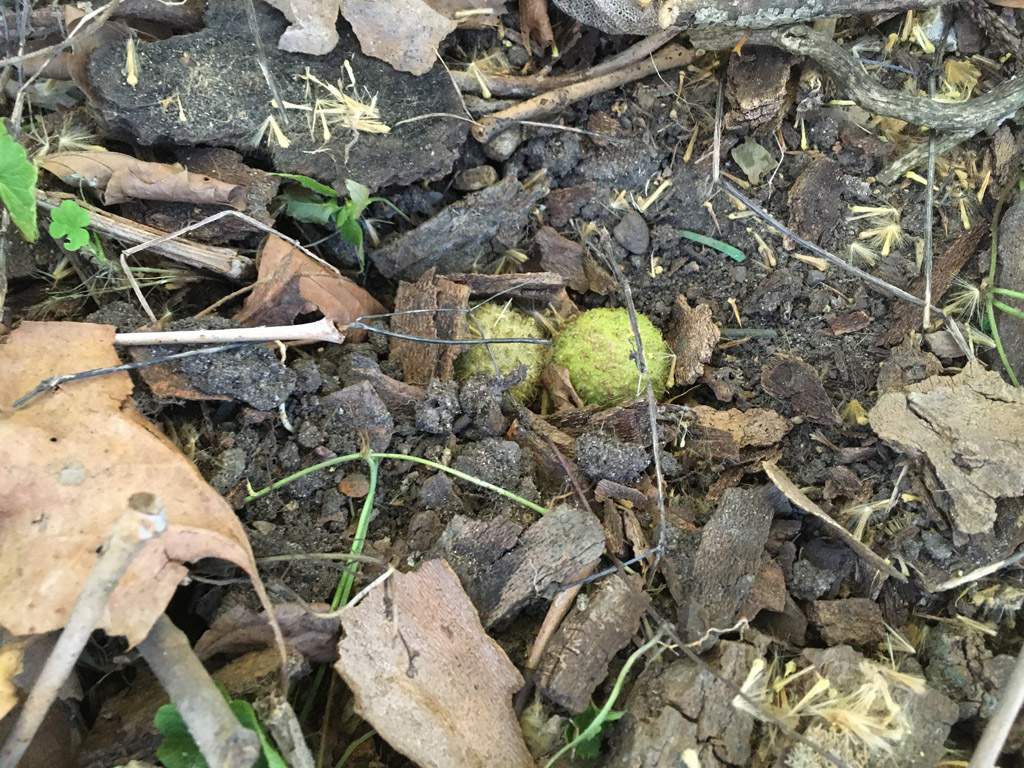
Chicken Little I was not. But still, I wondered why? The breeze was intermittent, and at this moment, barely had a breath to give.
Caught red-handed
After several curious glances above, a frenetic flutter fifty feet up told me the answer. It was not a large, sports-addled neighbor, but a tiny, seed-addled squirrel, and it was putting me to shame — going about its falltime tasks more diligently than I.
But what task was this? What would a single squirrel want with so many seed balls, and why did it want them on the ground, and not the tree?
Undaunted by my skepticism, it went about its work. It would climb from a branch to a hanging twig, from which were hanging several seed balls. It would reach down, grab one of them with its two front paws, and nibble off the stem. Then, very deliberately, it would pull its paws apart, and watch it intently as it fell, until it hit the ground — often hitting the roof along the way. Only after the ball had come to rest, would it repeat the process, with another, and then another. It was hard to tell if it was working, or having fun, or just tormenting me — it would have looked the same. But it was definitely a deliberate act.
Sycamores usually hang on to their seed balls all winter, snugly stuck aloft by a tenacious stem, from which they hope to fluff out their seeds on an April breeze. But not this one, this year. Every one on the ground bore evidence of an unexpected fall, its stem deliberately severed near the base. A few were gathered up in certain spots, but the rest, a multitude, were simply left to lie upon the ground, to weather the snows and the rains however they might. Judging from its preference for dropping them over hiding them, I think there must have been at least a little fun involved.
Or else it saw how I’d looked after the gutters, and knew it needn’t bother.
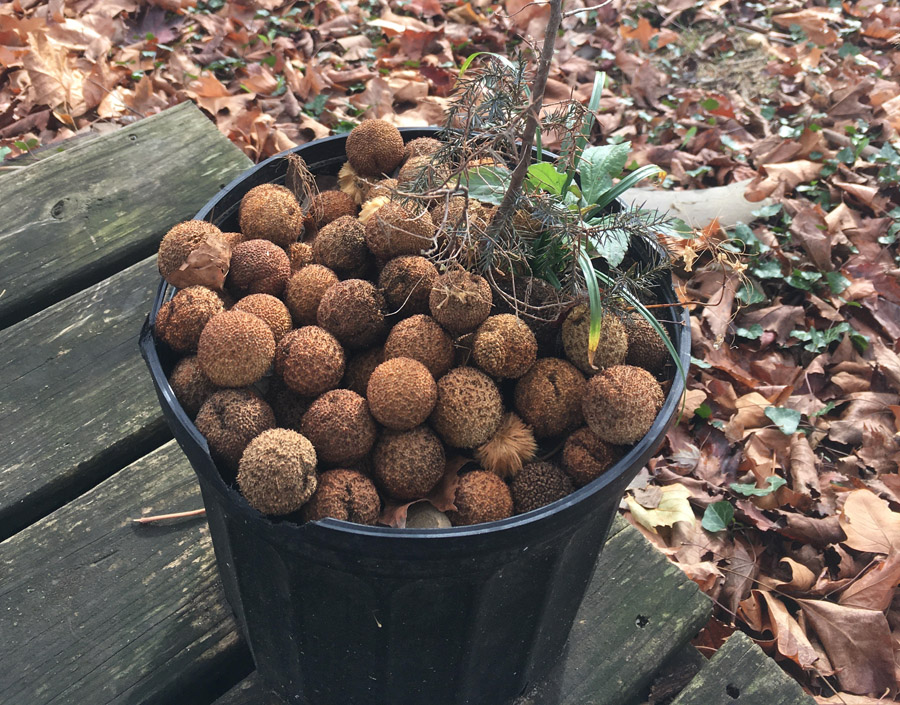
Haunt or habitat?
The small size and frenetic movement of the red squirrel, Tamiasciurus hudsonicus, was a pleasing sight in place of the relatively fat, lethargic, and overpopulated fox squirrel, Sciurus niger, who despite being native has developed a bad habit of finding ways into the house and regularly raiding the birdfeeders. Hudsonicus is quite rare in comparison, and much too shy for such things. I’d never seen one so close to the house before. But all that winter and the following spring, I’d often catch a phantom blur already skipping away along the woodpile the moment I’d stepped outside. Only when it formed a habit of visiting my deck to take a drink of rainwater did I manage to identify it for sure, by the white ring around its eyes.
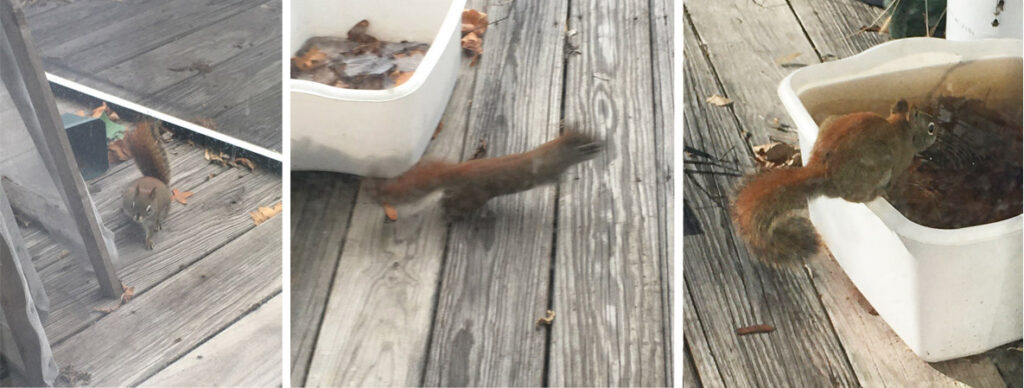
Having also been newly introduced to the abundance of the sycamore’s fruit, I did a little research on that as well. Like the hickory and many other trees, the sycamore, or Platanus occidentalis, produces in cycles — having the occasional very good year, separated by a number of lazier years. Their balls typically don’t drop on their own, so if your yard becomes carpeted with them, you’ve got a new neighbor. Other than as wildlife food or seed stock, the only apparent economic use for the seed balls is for crafting, as a component of various types of decorative projects, such as autumn wreaths and the like, that you might see at a craft market or in a shop display.
Most sources were a bit imprecise about exactly what wildlife eats the seeds, with most suggesting that it’s primarily birds, and one clever blogger claiming that they are not well liked because they lack ‘deliciousness.’ To this pithy conjecture I am happy to contribute the results of my own primary research, which shows that red squirrels eagerly utilize them as a food source; that they first eat the outer covering of the ball and then tear it apart to get at the tiny seeds inside; and that they find both sufficiently delicious to keep it up all winter long.
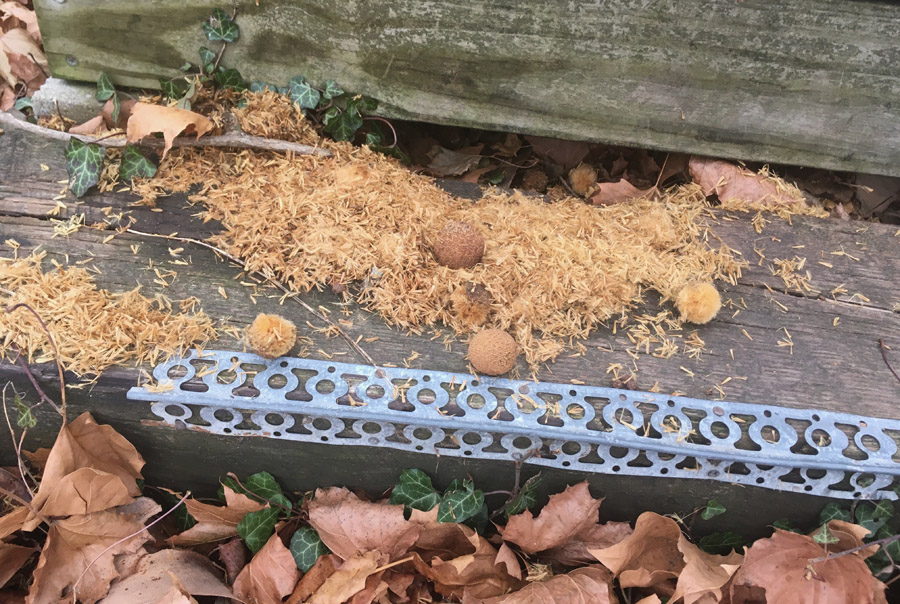
All this was over a year ago. This fall, the sycamore seed-balls were fewer, and they all stayed in the tree; and no shadowy spectre has fled along the woodpile every time I’ve walked outside. Hudsonicus, and to some extent the sycamore, have had their banner year. Sciurus niger is back to his usual tricks, thumping across the roof, looking for ways inside, and getting drunk on rotten crabapples.
I’d just about forgotten it all until, when in Paris recently, I came upon a shop display that featured a collection of some sort of seed balls, tinted a fashionable shade of slate, and rather resembling those of the sycamore. I stopped in my tracks. Had this obscure American forest fodder finally made the big time?
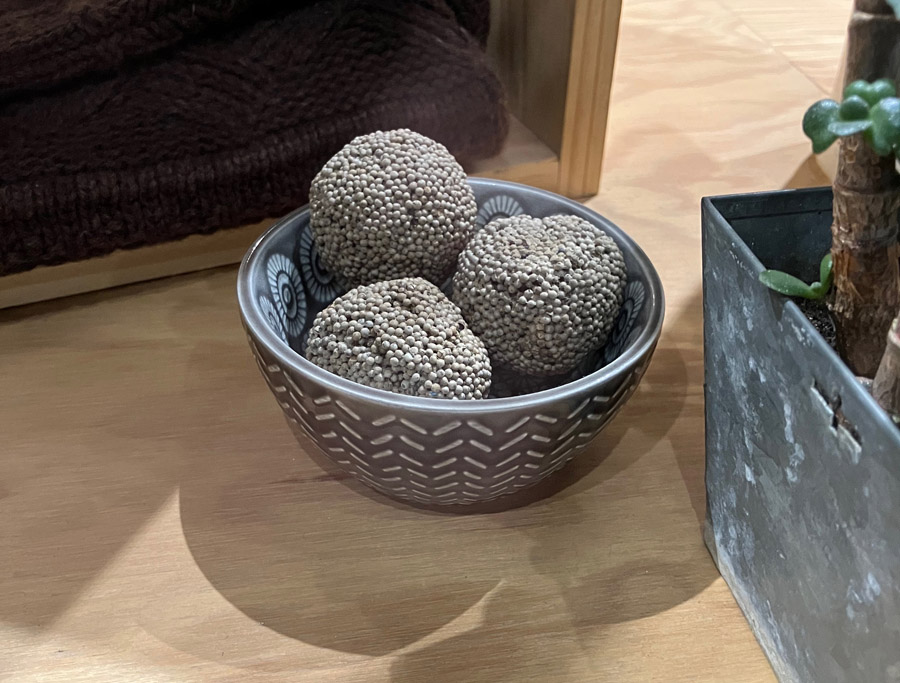
But enlarging and examining the photo later, these seem to be specimens of Craspedia globosa, known also as ‘billy buttons,’ a common component of flower bouquets — encountered more often at Trader Joe’s than in an unkempt yard.
Perhaps someday, lowly sycamore, you’ll find a Paris shop display — but not today.
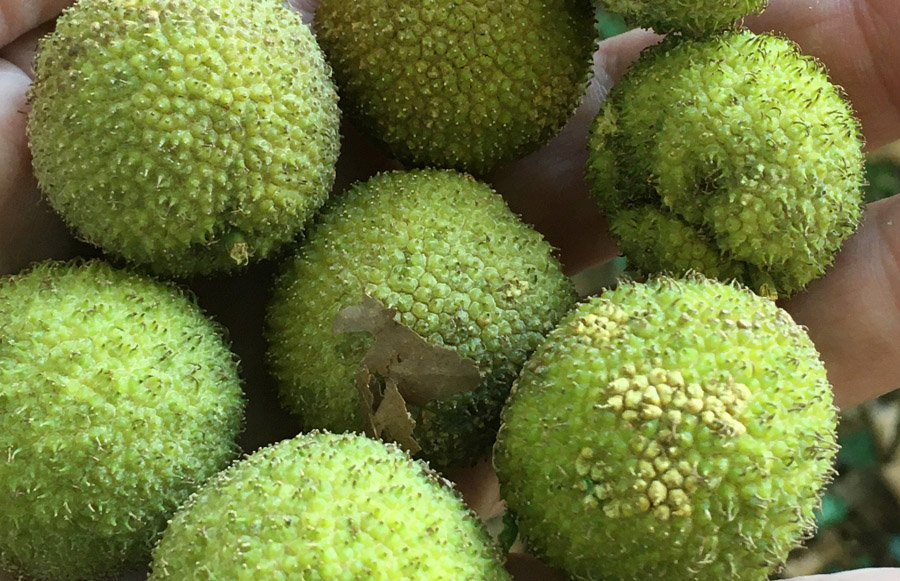
Article and photos Copyright 2023.
To be notified of new articles, visit https://whatshallweweird.com/subscribe/
